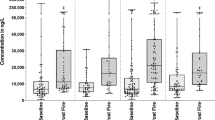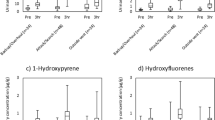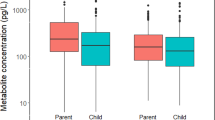Abstract
Urinary methoxyphenols (MPs) have been proposed as biomarkers of woodsmoke exposure. However, few field studies have been undertaken to evaluate the relationship between woodsmoke exposure and urinary MP concentrations. We conducted a pilot study at the US Forest Service — Savannah River Site, in which carbon monoxide (CO), levoglucosan (LG), and particulate matter (PM2.5) exposures were measured in wildland firefighters on prescribed burn days. Pre- and post-shift urine samples were collected from each subject, and cross-shift changes in creatinine-corrected urinary MP concentrations were calculated. Correlations between exposure measures and creatine-adjusted urinary MP concentrations were explored, and regression models were developed relating changes in urinary MP concentrations to measured exposure levels. Full-shift measurements were made on 13 firefighters over 20 work shifts in winter 2004 at the US Forest Service Savannah River site, a National Environmental Research Park. The average workshift length across the 20 measured shifts was 701±95 min. LG and CO exposures were significantly correlated for samples where the filter measurement captured at least 60% of the work shift (16 samples), as well as for the smaller set of full-shift exposure samples (n=9). PM2.5 and CO exposures were not significantly correlated, and LG and PM2.5 exposures were only significantly correlated for samples representing at least 60% of the work shift. Creatinine-corrected urinary concentrations for 20 of the 22 MPs showed cross-shift increases, with 14 of these changes showing statistical significance. Individual and summed creatinine-adjusted guaiacol urinary MPs were highly associated with CO (and, to a lesser degree, LG) exposure levels, and random-effects regression models including CO and LG exposure levels explained up to 80% of the variance in cross-shift changes in summed creatinine-adjusted guaiacol urinary MP concentrations. Although limited by the small sample size, this pilot study demonstrates that urinary MP concentrations may be effective biomarkers of occupational exposure to wood smoke among wildland firefighters.
This is a preview of subscription content, access via your institution
Access options
Subscribe to this journal
Receive 6 print issues and online access
$259.00 per year
only $43.17 per issue
Buy this article
- Purchase on Springer Link
- Instant access to full article PDF
Prices may be subject to local taxes which are calculated during checkout



Similar content being viewed by others
References
ACGIH. Threshold Limit Values and Biological Exposure Indices Cincinnatti. American Conference of Governmental Industrial Hygienists, OH, 2006.
Caux C., O'Brien C., and Viau C. Determination of firefighter exposure to polycyclic aromatic hydrocarbons and benzene during fire fighting using measurement of biological indicators. Appl Occup Environ Hyg 2002: 17: 379–386.
Clark M., Paulsen M., Smith K.R., Canuz E., and Simpson C.D. Urinary methoxyphenol biomarkers and woodsmoke exposure: comparisons in rural Guatemala with personal CO and kitchen CO, levoglucosan, and PM2.5 . Environ Sci Technol 2007: 41: 3481–3487.
Dills R.L., Paulsen M., Ahmad J., Kalman D.A., Elias F.N., and Simpson C.D. Evaluation of urinary methoxyphenols as biomarkers of woodsmoke exposure. Environ Sci Technol 2006: 40: 2163–2170.
Dills R.L., Zhu X., and Kalman D.A. Measurement of urinary methoxyphenols and their use for biological monitoring of wood smoke exposure. Environ Res 2001: 85: 145–158.
Gold A., Burgess W.A., and Clougherty E.V. Exposure of firefighters to toxic air contaminants. Am Ind Hyg Assoc J 1978: 39: 534–539.
Guidotti T.L., and Clough V.M. Occupational health concerns of firefighting. Annu Rev Public Health 1992: 13: 151–171.
Harrison R., Materna B.L., and Rothman N. Respiratory health hazards and lung function in wildland firefighters. Occup Med 1995: 10: 857–870.
Hawthorne S.B., Kreiger M.S., Miller D.J., and Mathiason M.B. Collection and quantitation of methoxylated phenol tracers for atmospheric pollution from residential wood stoves. Environ Sci Tech 1989: 23: 470–475.
Kato M., Loomis D., Brooks L.M., Gattas G.F., Gomes L., Carvalho A.B., Rego M.A., and DeMarini D.M. Urinary biomarkers in charcoal workers exposed to wood smoke in Bahia State, Brazil. Cancer Epidemiol Biomarkers Prev 2004: 13: 1005–1012.
Lee S., Baumann K., Schauer J.J., Sheesley R.J., Naeher L.P., Meinardi S., Blake D.R., Edgerton E.S., Russell A.G., and Clements M. Gaseous and particulate emissions from prescribed burning in Georgia. Environ Sci Technol 2005: 39: 9049–9056.
Miller J.J., Powell G.M., Olavesen A.H., and Curtis C.G. The fate of 2,6-dimethoxy (U-14C) phenol in the rat. Xenobiotica 1974: 4: 285–289.
Naeher L.P., Achtemeier G.L., Glitzenstein J.S., Streng D.R., and Macintosh D. Real-time and time-integrated PM(2.5) and CO from prescribed burns in chipped and non-chipped plots: firefighter and community exposure and health implications. J Expo Sci Environ Epidemiol 2006: 16: 351–361.
Ogata N., Matsushima N., and Shibata T. Pharmacokinetics of wood creosote: glucuronic acid and sulfate conjugation of phenolic compounds. Pharmacology 1995: 51: 195–204.
OSHA. Permissible Exposure Limits for Air Contaminants. Code of Federal Regulations 29CFR1910.10, Department of Labor, Occupational Safety and Health Administration, Washington, DC, Table Z-1. 2006.
Reinhardt T.E., and Ottmar R.D. Baseline measurements of smoke exposure among wildland firefighters. J Occup Environ Hyg 2004: 1: 593–606.
Schauer J.J., Kleeman M.J., Cass G.R., and Simoneit B.R. Measurement of emissions from air pollution sources. 3. C1-C29 organic compounds from fireplace combustion of wood. Environ Sci Technol 2001: 35: 1716–1728.
Sheesley R.J., Schauer J.J., Chowdhury Z., Cass G.R., and Simoneit B.R.T. Characterization of organic aerosols emitted from the combustion of biomass indigenous to South Asia. J Geophys Res 2003: 108: 4285.
Simoneit B.R.T., Rogge W.F., Mazurek M.A., Standley L.J., Hilderman L.M., and Cass G.R. Lignin pyrolysis products, lignans, and resin acids as specific tracers of plant classes in emissions from biomass combustion. Environ Sci Technol 1993: 27: 2533–2541.
Simpson C.D., Dills R.L., Katz B.S., and Kalman D.A. Determination of levoglucosan in atmospheric fine particulate matter. J Air Waste Manage Assoc 2004: 54: 689–694.
Simpson C.D., Paulsen M., Dills R.L., Liu L-J.S., and Kalman D.A Determination of methoxyphenols in ambient atmospheric particulate matter: tracers for wood combustion. Environ Sci Technol 2005: 39: 631–637.
Strand L.P., and Scheline R.R. The metabolism of vanillin and isovanillin in the rat. Xenobiotica 1975: 5: 49–63.
USDA. Fact Sheet: United States Forest Service — Savannah River, USDA Forest Service, Aitken, SC 2004.
Ward T.J., Hamilton R.F., Dixon R.W., Paulsen M., and Simpson C.D. Characterization and evaluation of smoke tracers in PM: results from the 2003 Montana wildfire season. Atmos Environ 2006: 40: 7005–7017.
Acknowledgements
We gratefully acknowledge Dana Barr for undertaking the creatinine analysis; John Blake and Gary Achtemeier for support and collaboration in our smoke-related exposure research; and Jeff Prevey, Paul Linse, Mark Frizzell, Dan Shea, Chris Hobson, and the firefighters for support and participation in this study. This research was done at the Savannah River Site Environmental Research Lab (SRS) — SRS is a National Environmental Research Park. This work was funded in part by the Northwest Center for Particulate Air Pollution and Health (US EPA Grant no. CR827355) and the National Institute of Occupational Safety and Health (no. R03-OH007656). Funding and support was also provided by the Department of Energy — Savannah River Operations Office through the US Forest Service Savannah River under Interagency Agreement DE-AI09-00SR22188.
Author information
Authors and Affiliations
Corresponding author
Rights and permissions
About this article
Cite this article
Neitzel, R., Naeher, L., Paulsen, M. et al. Biological monitoring of smoke exposure among wildland firefighters: A pilot study comparing urinary methoxyphenols with personal exposures to carbon monoxide, particular matter, and levoglucosan. J Expo Sci Environ Epidemiol 19, 349–358 (2009). https://doi.org/10.1038/jes.2008.21
Received:
Accepted:
Published:
Issue Date:
DOI: https://doi.org/10.1038/jes.2008.21
Keywords
This article is cited by
-
Hydroxylated polycyclic aromatic hydrocarbons as biomarkers of exposure to wood smoke in wildland firefighters
Journal of Exposure Science & Environmental Epidemiology (2017)
-
Toxicity of wood smoke particles in human A549 lung epithelial cells: the role of PAHs, soot and zinc
Archives of Toxicology (2016)
-
Characterization of odorants in human urine using a combined chemo-analytical and human-sensory approach: a potential diagnostic strategy
Metabolomics (2013)
-
Impact of nitrogen and climate change interactions on ambient air pollution and human health
Biogeochemistry (2013)
-
Urinary levoglucosan as a biomarker of wood smoke: Results of human exposure studies
Journal of Exposure Science & Environmental Epidemiology (2010)



